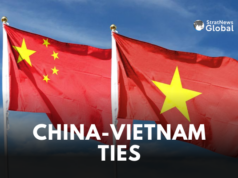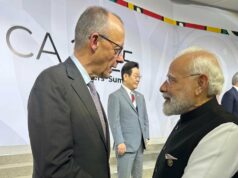NEW DELHI: Call it the Covid effect but the third Arctic Science Ministerial hosted virtually by Iceland and Japan last month happened with apparently little notice. But to those interested in the Arctic, it signalled India’s renewed focus on a region more than 4000-km distant yet critical to its economy. Scientists and officials involved in polar research and policy confirmed to StratNews Global that long pending plans to invest in a polar research vessel or icebreaker are being worked on; Canada has opened its doors to Indian scientists wanting to study weather and climate phenomena in the northern subarctic part of the country; similar cooperation with Russia and Sweden are on the cards; there are plans to ensure the Himadri station in Norway is staffed year round.
All this effort flows from the need to better understand how the Arctic weather patterns impact the Indian monsoon. The urgency cannot be understated. Climatologists are predicting that Arctic waters will be free of surface ice by 2050 if not earlier, and that has triggered a geopolitical scramble between Russia and the U.S. for the estimated 90 billion barrels of oil lying beneath. Add to that, gas and rare earth metals and the world’s two nuclear heavyweights are flexing military muscle.
Are these prizes worth going to war about? Hopefully not, but the jockeying and manoeuvring is expected to intensify as countries look to grab first-mover advantage. Some countries have an edge over the others, notably the Arctic 8 (Russia, Canada, Finland, Norway, Sweden, Denmark, Iceland), because of their Arctic territories or the U.S. which because of Alaska, borders the Arctic. They make up the Arctic Council and even as they compete among themselves, they ensure outsiders stay out. Thus China, which styles itself as a “near Arctic” state, has had its claims (or pretensions) rejected and has had to leverage its phenomenal money power in the hope of getting a foot into the Arctic door.
It has invested in Russia’s Yamal project for an assured four million tonnes of LNG every year; it is also a customer for the oil sitting at the bottom of the Arctic; it is investing in infrastructure that will facilitate its Polar Silk Route, cutting shipping times from Europe to Asia through the Arctic Northwest passage by 4000 km, enabling savings to the tune of $200,000.
Former diplomat Navtej Sarna believes that “China is into the game in a big way and whatever it gains or does changes the strategic equations with India, so we have to be aware of that and see what we can do”.
Members of the Arctic Council suspect China will sooner rather than later bare its military fangs. This is something even the Russians acknowledge although not in public. So China has observer status in the Arctic Council, meaning it can observe the proceedings and not participate.
India is also an observer and as Navtej Sarna, who was involved in the Arctic negotiations, put it: “India has fundamental interests in the Arctic and also has a historic interest and good experience in polar research. Experience in Antarctica prepared us for the Arctic and that is why we pitched for observer status and got it. Our interest is climate and what we can learn from research on climate since it has a direct impact on us, long coastlines subject to changes in the monsoon and its impact on the third pole (Himalayas). Our main plank was scientific and not commercial.”
But as an official pointed out, India’s place in the Arctic Council is not permanent and its scientific activities alone will determine whether it keeps its place. Since 2008, the Himadri observatory in Svalbard, Norway, has carried out studies and observations in space weather, aerosol radiation, glaciers, sedimentology and carbon recycling. The team stays in place only through the summers although plans are underway to extend the period of stay through the long harsh winter.
Efforts are on to augment Arctic observations from space. Sometime in the middle of next year, the Indian Space Research Organisation (ISRO) and the National Aeronautics & Space Administration (NASA) will jointly launch a Synthetic Aperture Radar satellite mission that will, over three years, carry out global measurements of land surface changes using radar imaging. More important, it will provide data on the warming of the Arctic. The mission came up for discussion during the third Arctic Science Ministerial.
A word on the draft Arctic Policy unveiled early this year. It gives shape and form to India’s Arctic activities, explaining the rationale and placing science at the top as a tool to approach the Arctic. Although the draft does not pretend that India is a “near Arctic” country, it underscores that India considers itself a part of the polar region (given its impact on the Indian monsoon) and will engage actively.
The criticism lies in the ambiguity surrounding what India will bring to the Arctic table and how it can use its potential and expertise for the good of the region. The draft recognises the sovereignty of the Arctic states but in the same breath it talks of the Arctic being the “common heritage of mankind”. So does it mean India wants the Arctic at some point to be like Antarctica, which is global commons? It also refers to the sustained and responsible exploitation of Arctic resources, but such exploitation is inherently damaging to the environment.
These are questions that India will be asked as it seeks to broaden its involvement in the Arctic. In that sense, given that this is a draft policy, India has time to finesse its position and bring a whole of government approach involving not only the ministries of earth sciences and external affairs but also environment, transport, defence and so on. But the clock is ticking; other actors have already stated their positions and are manoeuvring for advantage. Now more than ever before, India has to up its game and quickly.
Thirty eight years in journalism, widely travelled, history buff with a preference for Old Monk Rum. Current interest/focus spans China, Technology and Trade. Recent reads: Steven Colls Directorate S and Alexander Frater's Chasing the Monsoon. Netflix/Prime video junkie. Loves animal videos on Facebook. Reluctant tweeter.





